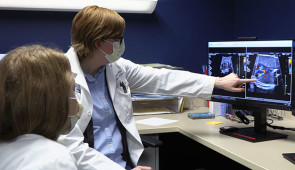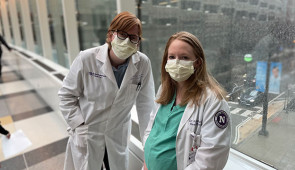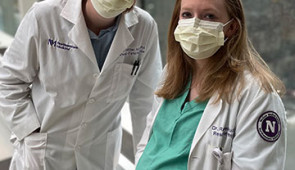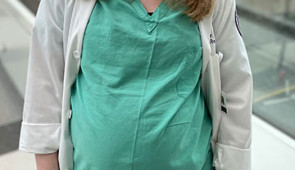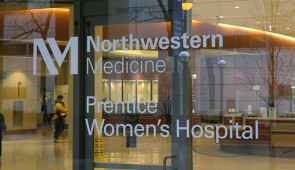COVID-19 vaccine not associated with birth defects detectable on ultrasound
Findings fill gap left vacant when pregnant people were excluded from the initial trials
- Link to: Northwestern Now Story
CHICAGO --- The exclusion of pregnant patients in initial COVID-19 vaccine clinical trials left many patients and doctors wondering how the vaccine might affect pregnant patients and their unborn babies. A new Northwestern Medicine study has found the vaccine is not associated with birth defects that are detectable on ultrasound.
“This is yet another important piece of data that helps bridge the chasm that was left when pregnant individuals were excluded from those initial vaccine trials,” said corresponding author Dr. Emily Miller, chief of obstetrics at Northwestern Medicine and assistant professor of maternal fetal medicine at Northwestern University Feinberg School of Medicine.
The study was published April 4 in the journal JAMA Pediatrics.
“One of the reasons women struggle with the vaccine in pregnancy is they’re worried about their babies and don’t want to take any risks,” said first author Dr. Rachel Ruderman, a fourth-year resident in obstetrics and gynecology at Feinberg. “This study shows there really is no increased risk of birth defects, and it supports other evidence that shows the vaccine is safe and beneficial for mom and baby.”
Study analyzed for a wide range of birth defects
The types of birth defects the scientists were looking for on the study participants’ ultrasounds were ones they deemed “major fetal structural anomalies,” such as the baby’s heart not forming correctly or the spine not closing properly. In the United States, 3 to 5% of births are impacted by these types of defects, resulting in increases in infant morbidity, mortality and billions of dollars in cost.
“During the early part of pregnancy when the organs are forming, there can be abnormalities in how they form, and they can take the form of birth defects that can have implications for the life of the child,” Miller said.
“For example, if the baby’s heart isn’t forming correctly, that could lead to the baby needing major cardiac surgery or long-term medication,” Miller said. “However, if the ultrasound identified extra fluid in the fetus’ kidney, that might end up fixing itself down the road. We looked for those extremes and everything in between.”
Study advances CDC’s previous findings
The U.S. Centers for Disease Control and Prevention (CDC) in September 2021 released similar findings from its study in pregnant individuals. This study builds on and advances the CDC’s data, Miller said.
While the CDC compared its study data to historical data, the new Northwestern study used contemporary controls—current pregnant patients who chose not to get vaccinated or were not vaccinated within the window the scientists defined as of biologic risk for birth defects (having received vaccination from 30 days prior to conception until 14 weeks gestational age).
“I think the big strength of this study is that we compared against other women who were vaccinated, but at different point in their pregnancies,” Miller said. “People who choose vaccination are often different from people who choose not to be vaccinated. Our study design helps account for some of those differences.”
The study analyzed electronic medical records (including ultrasounds and COVID-19 vaccination records) from a cohort of 3,156 pregnant people who received a complete fetal anatomical survey (19-week ultrasound) at Northwestern Medicine Prentice Women’s Hospital between March and November 2021. Of those pregnant patients, 2,622 (83.1%) received at least one vaccine dose and 1,149 (43.8%) were vaccinated inside of the scientists’ defined vaccination window (30 days prior to conception until 14 weeks gestational age).
Findings will hopefully further boost trust in vaccines
Both Miller and Ruderman see patients at Prentice. As part of her residency, Ruderman also sees patients at the John H. Stroger, Jr. Hospital of Cook County. Despite new and emerging data that continue to support the safety of vaccination among pregnant individuals, hesitancy is still present, they said.
“Patients say, ‘I don’t think the data is good, and everyone is getting COVID anyway, so why would I expose my baby?’” said Ruderman, who received her booster shot during week 12 of pregnancy. “Then I tell people, ‘Actually, the data is really good,’ and I feel like they’re receptive. So, these findings will only add to that.”
Multimedia Downloads
Scientists
